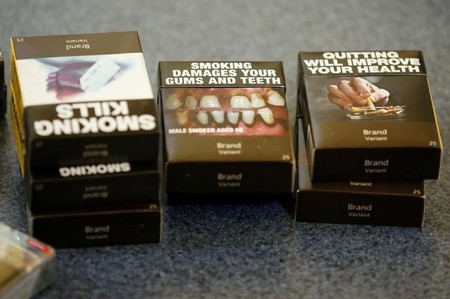By Lisa Rapaport
(Reuters Health) – Gruesome pictures on cigarette packages may convince more smokers to quit, a U.S. study suggests.
In a four-week experiment, researchers randomly assigned about 2,150 adult smokers to receive either text-only or photo-enhanced warnings on their cigarette packs.
With pictures, smokers were 29 percent more likely to try quitting during the study.
Quitting for at least a week before the end of the study was 53 percent more likely with photos than with text alone.
“Smokers told us that the pictorial warnings didn’t make them feel any more at risk for harm from smoking. However, the pictorial warnings made the harms of smoking ever present and vivid, while the usual text warnings were bland, stale, and easy to ignore,” said lead study author Noel Brewer, a public health researcher at the University of North Carolina at Chapel Hill, in email to Reuters Health.
Once a week for four weeks, participants in the study visited the researchers’ clinic and brought along an eight-day supply of cigarettes. Every week, researchers put stickers on participants’ cigarette packages, either with pictures and text, or just with text.
The researchers removed the cellophane from the outside of the packages and affixed the stickers directly to the packs, covering the existing U.S. Surgeon General’s warnings with the messages designed for the experiment.
At each visit, smokers also filled out surveys indicating whether they had tried to quit.
To be included in the study, people had to smoke at least seven cigarettes a week. They were told that the point of the study was to see how well they understood the labels on their cigarette packs.
Photo warnings included a close-up shot of rotting teeth with the message “Warning: cigarettes cause cancer,” and an image of a gaunt, bald, bedridden person juxtaposed with “Warning: smoking can kill you.”
Text-only warnings followed some Surgeon’s General statements, such as “Quitting smoking now greatly reduces serious risks to your health,” and “Smoking causes lung cancer, heart disease, emphysema and may complicate pregnancy.”
With pictures, 40 percent of smokers said they tried to quit during the study, compared with 34 percent of participants who received only text warnings, researchers report in JAMA Internal Medicine.
In addition, 5.7 percent of the people who received photo warnings quit for at least one week prior to the end of the study, compared with 3.8 percent for the word-only messages.
“Pictorial warnings also increased forgoing a cigarette, intentions to quit smoking, negative emotional reactions, thinking about the harms of smoking, and conversations about quitting,” the authors reported.
One limitation of the study is that people who joined the experiment may have had a greater desire to quit than typical smokers, the researchers also point out.
It’s hard to say whether photos would have the same impact over a long period of time, or if the novelty of the warnings encouraged people to quit, the authors note.
“Current warnings in the United States are small and barely noticeable, as they are on the side of the cigarette packages and have had the same messages for over 30 years,” said Jim Thrasher, a public health researcher at the University of South Carolina who wasn’t involved in the study.
“The data are very consistent across a range of different studies in different cultural contexts – graphic warnings on cigarette packages do a better job than warnings with only text when informing consumers about the many serious health risks from smoking and in promoting smoking cessation,” Thrasher added by email.
Roughly 70 countries outside the U.S. already have regulations requiring pictorial warnings similar to the ones tested in the current study, noted David Hammond, a public health researcher at the University of Waterloo in Ontario, Canada, who wasn’t involved in the study.
“Viewing an image of the effects of lung cancer or heart disease communicates the severity of smoking-related disease far more effectively than words alone,” Hammond said by email.
SOURCE: http://bit.ly/1TWBAGn JAMA Internal Medicine, online June 6, 2016.


